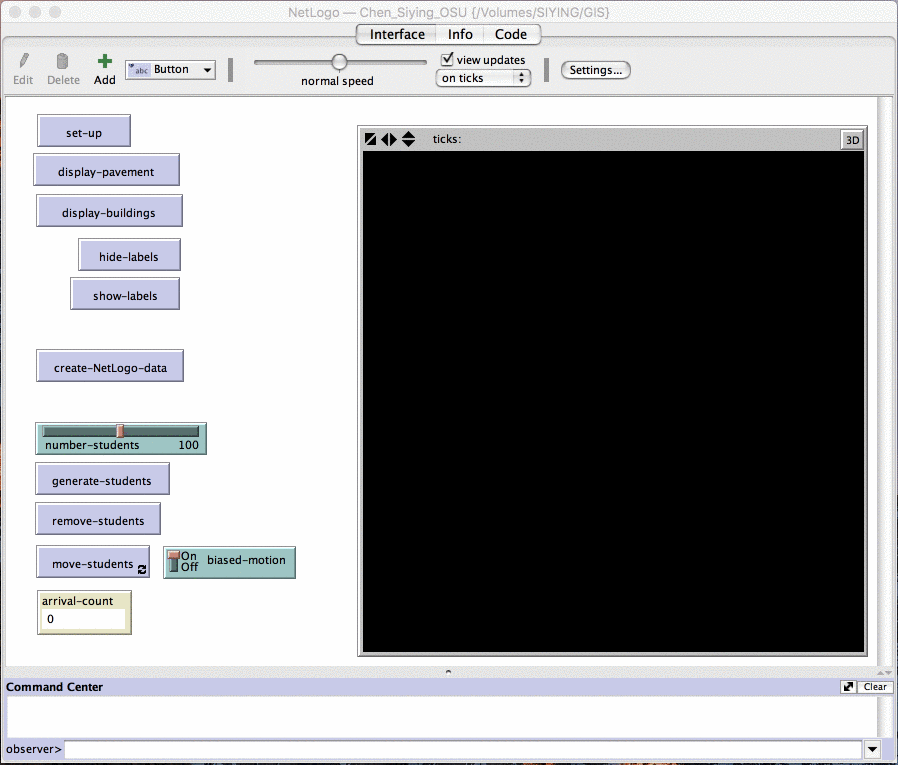I developed this model to simulate simple random motion and biased random motion within constrained space. The major difference with the previous model is that this model loads pre-created GIS data to generate NetLogo data.
How this model works:
- This program loads the GIS data of the Ohio State University buildings and pavement from shapefiles.
- It generates NetLogo data and picks a random building as a
targetfor student movement. - It generates up to 200 students at random buildings.
- It allows students to move only within buildings (green patches) and orange patches (pavement).
- User can define whether student motion is random or biased towards the target building.
random-motioninvolves a simple heuristic - test whether the patch in front of the student is feasible (green or orange); if so, move forward to that patch. If not, a student makes a random left turn. Withbiased-motion, a student turns to face the target after a successful move forward. test-arrivaltests if a student is within 5 units of the target. If so, the student moves to that target, is removed, and the arrival-count is incremented.
Demo:

To set up, the model loads the GIS data and sets the envelope for the NetLogo world.
extensions [ gis ]
globals [ pavement building centroid arrival-count target]
breed [building-labels building-label]
breed [target-building-labels target-building-label] ; this breed is not necessarily used in my code
breed [students student]
to set-up
ca
set pavement gis:load-dataset "OSU_data/pavement.shp"
set building gis:load-dataset "OSU_data/buildings.shp"
gis:set-world-envelope (gis:envelope-union-of
(gis:envelope-of pavement)
(gis:envelope-of building) )
set arrival-count 0 ; reset the number of arrived students
reset-ticks
end
hide-labels and show-labels ask the building-labels to show themselves.
to display-buildings
ask building-labels [die]
gis:set-drawing-color green
gis:draw building 3
foreach gis:feature-list-of building
[ set centroid gis:location-of gis:centroid-of ?
if not empty? centroid
[ create-building-labels 1
[ set xcor item 0 centroid
set ycor item 1 centroid
set size 0
set label gis:property-value ? "BLDG_NAME" ] ] ]
end
to display-pavement
gis:set-drawing-color red
gis:draw pavement 1
end
to hide-labels
ask building-labels [hide-turtle]
end
to show-labels
ask building-labels [show-turtle]
end
create-buildings generates green patches based on the building shapefile. create-paths generates orange patches based on the pavement shapefile. A random building (building-label) is designated as the target.
to create-NetLogo-data
create-buildings
create-paths
end
to create-buildings
if not any? building-labels [display-buildings]
ask building-labels [hide-turtle]
ask patches gis:intersecting building
[set pcolor green]
set target one-of building-labels
ask target [show-turtle]
end
to create-paths
ask patches gis:intersecting pavement
[ set pcolor orange ]
end
The model uses the input of number-student to create students at random green patches (buildings).
to generate-students
ask n-of number-students patches with [pcolor = green]
[ sprout-students 1 [
set color white
set shape "person student"
set size 15 ]
]
end
remove-students asks students to die and resets the arrvial-count, the number of students who have arrived at the target.
to remove-students
ask students [die]
set arrival-count 0
end
To initiate student movement, if biased-motion is switched on, students turn to face the target. Otherwise, they make a random left turn. Students can only move forward if the patch in front of them is feasible (either green or orange). If they move to the edge of the NetLogo world, they make a random left turn.
to move-students
if not any? students [ stop ]
ask students [
random-motion ; random motion of students
test-arrival ; test if the student has arrived at the target
]
tick
end
to random-motion
ifelse patch-ahead 1 != nobody [
ifelse [pcolor] of patch-ahead 1 = green or [pcolor] of patch-ahead 1 = orange
[ fd 1 ; the student moves forward to that patch
if biased-motion [ face target] ]
[ lt random-float 360 ]
]
[ lt random-float 360 ]
end
test-arrival tests if a student is within five units of the target. Five patches is necessary since a building centroid may be in an interior courtyard and not part of the building. The optimal distance could be more or less. Arrived students will disappear from the NetLogo world.
to test-arrival
if (distance target) <= 5 [
move-to target
set arrival-count arrival-count + 1
die ]
end
